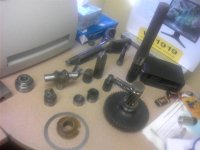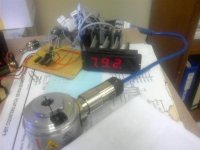Oh boy.

Good eye.
This was *almost* an excellent project. Actually, you might even have a parts source so I can finish it...
A lot of times on the back of the motors we build, the customer requests a rotary encoder for pulse counting, positioning, speed monitoring, etc. The ones we have in stock here are either 512 PPR or 1024 PPR, and either TTL (5VDC supply or HTL (10-30VDC).
Since we don't do any of the controls out of this office, if someone has a complaint that an encoder isn't working, we really have no way to check it. So one day at my buddy's junkyard I came across 4 of these little modular boards that had a 7-segment LED and SN74143N 4-bit counter/latch and LED driver. They just take a simple pulse input and increment the number shown on the LED, and they have carryover bits and all that fun kind of stuff so you can string them all together.
So those are the guts of what you're looking at...the breadboard is for signal routing and power distribution. The combined 18VDC hits a series of voltage regulators that send 5VDC to the LED drivers and then either 5VDC or 12VDC to the encoder depending on which range I wanna test. Since the drivers only want 5V, if I select 12V for the encoder, the return signal goes through an additional 5V regulator to step it down. Another switch chooses whether you want the A- or B- channel on the encoder.
I wired the encoder power feeds and signal lines into a push-down Ethernet connector jack, and made a dongle to go between that and the plug on the encoder itself. Reason being I could easily make another dongle for testing something with a different style plug.
So when it's all hooked up, you spin the encoder, each pulse increments the counter, and the index pulse resets the counter back to zero. So just by turning it (or this could be done with the encoder on a motor somewhere in the field), you can check whether both channels are pulsing, whether the index pulse is working, and what the pulse count of the encoder is.
All good, right?
Well, remember that I got these out of a random box of stuff at my buddy's junkyard. One of the modules was DOA, the other 3 "work", but one has a really high amp draw and heats up the SN74143N if you let it run too long, and also gets the dedicated 5VDC regulator really hot. I tried a while ago to find more of these boards but didn't find any, and now it's sat for long enough that I forgot all the pinouts & wiring information. So it works a little bit, but never got to the point where I could assemble it into the project enclosure (also in that pic) and call it good.
Considering I do mechanical & applications engineering here, I was kinda proud of this damn thing until the stupid boards didn't work.



